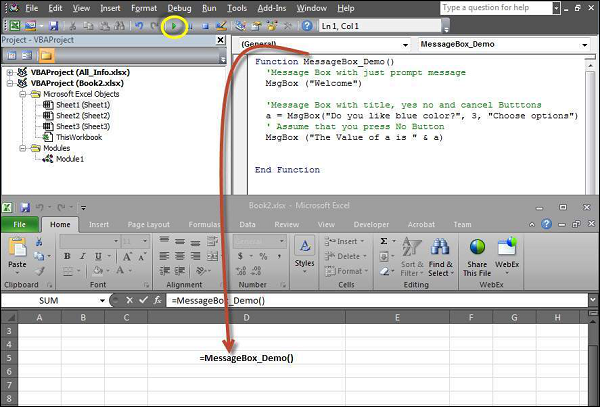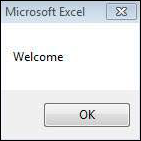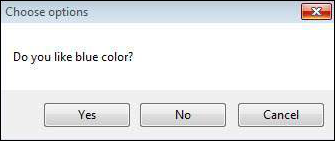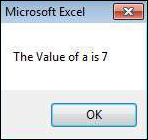The MsgBox function displays a message box and waits for the
user to click a button and then an action is performed based on the
button clicked by the user.
 Step 2 − A Simple Message box is displayed with a message "Welcome" and an "OK" Button
Step 2 − A Simple Message box is displayed with a message "Welcome" and an "OK" Button
 Step 3 − After Clicking OK, yet another dialog box is displayed with a message along with "yes, no, and cancel" buttons.
Step 3 − After Clicking OK, yet another dialog box is displayed with a message along with "yes, no, and cancel" buttons.
 Step 4 − After clicking the ‘No’ button, the value of that
button (7) is stored as an integer and displayed as a message box to the
user as shown in the following screenshot. Using this value, it can be
understood which button the user has clicked.
Step 4 − After clicking the ‘No’ button, the value of that
button (7) is stored as an integer and displayed as a message box to the
user as shown in the following screenshot. Using this value, it can be
understood which button the user has clicked.

Syntax
MsgBox(prompt[,buttons][,title][,helpfile,context])
Parameter Description
- Prompt − A Required Parameter. A String that is displayed as a message in the dialog box. The maximum length of prompt is approximately 1024 characters. If the message extends to more than a line, then the lines can be separated using a carriage return character (Chr(13)) or a linefeed character (Chr(10)) between each line.
- Buttons − An Optional Parameter. A Numeric expression that specifies the type of buttons to display, the icon style to use, the identity of the default button, and the modality of the message box. If left blank, the default value for buttons is 0.
- Title − An Optional Parameter. A String expression displayed in the title bar of the dialog box. If the title is left blank, the application name is placed in the title bar.
- Helpfile − An Optional Parameter. A String expression that identifies the Help file to use for providing context-sensitive help for the dialog box.
- Context − An Optional Parameter. A Numeric expression that identifies the Help context number assigned by the Help author to the appropriate Help topic. If context is provided, helpfile must also be provided.
- 0 vbOKOnly - Displays OK button only.
- 1 vbOKCancel - Displays OK and Cancel buttons.
- 2 vbAbortRetryIgnore - Displays Abort, Retry, and Ignore buttons.
- 3 vbYesNoCancel - Displays Yes, No, and Cancel buttons.
- 4 vbYesNo - Displays Yes and No buttons.
- 5 vbRetryCancel - Displays Retry and Cancel buttons.
- 16 vbCritical - Displays Critical Message icon.
- 32 vbQuestion - Displays Warning Query icon.
- 48 vbExclamation - Displays Warning Message icon.
- 64 vbInformation - Displays Information Message icon.
- 0 vbDefaultButton1 - First button is default.
- 256 vbDefaultButton2 - Second button is default.
- 512 vbDefaultButton3 - Third button is default.
- 768 vbDefaultButton4 - Fourth button is default.
- 0 vbApplicationModal Application modal - The current application will not work until the user responds to the message box.
- 4096 vbSystemModal System modal - All applications will not work until the user responds to the message box.
Return Values
The MsgBox function can return one of the following values which can be used to identify the button the user has clicked in the message box.- 1 - vbOK - OK was clicked
- 2 - vbCancel - Cancel was clicked
- 3 - vbAbort - Abort was clicked
- 4 - vbRetry - Retry was clicked
- 5 - vbIgnore - Ignore was clicked
- 6 - vbYes - Yes was clicked
- 7 - vbNo - No was clicked
Example
Function MessageBox_Demo() 'Message Box with just prompt message MsgBox("Welcome") 'Message Box with title, yes no and cancel Butttons a = MsgBox("Do you like blue color?",3,"Choose options") ' Assume that you press No Button msgbox ("The Value of a is " & a) End Function
Output
Step 1 − The above Function can be executed either by clicking the "Run" button on VBA Window or by calling the function from Excel Worksheet as shown in the following screenshot. Step 2 − A Simple Message box is displayed with a message "Welcome" and an "OK" Button
Step 2 − A Simple Message box is displayed with a message "Welcome" and an "OK" Button Step 3 − After Clicking OK, yet another dialog box is displayed with a message along with "yes, no, and cancel" buttons.
Step 3 − After Clicking OK, yet another dialog box is displayed with a message along with "yes, no, and cancel" buttons. Step 4 − After clicking the ‘No’ button, the value of that
button (7) is stored as an integer and displayed as a message box to the
user as shown in the following screenshot. Using this value, it can be
understood which button the user has clicked.
Step 4 − After clicking the ‘No’ button, the value of that
button (7) is stored as an integer and displayed as a message box to the
user as shown in the following screenshot. Using this value, it can be
understood which button the user has clicked.

No comments:
Post a Comment